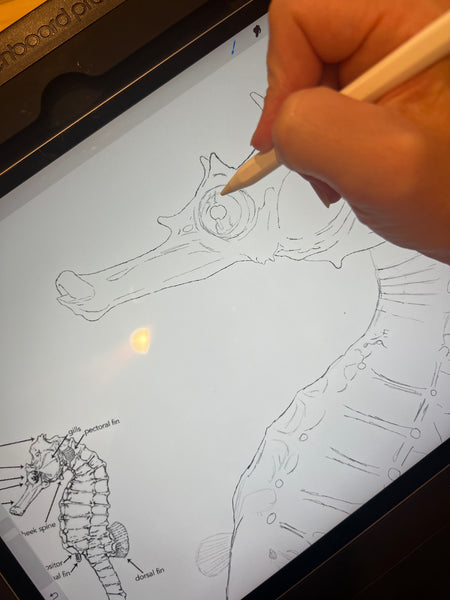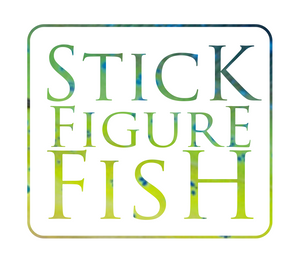Painting the White’s Seahorse and Black Rockcod
At the end of last year, I had the pleasure of collaborating with Oceanwatch to create an illustrated species ID guide for fishers in NSW offshore fisheries. This collaboration not only allowed me to contribute my skills as an artist but also to engage deeply with my passion for marine species identification as a tool for conservation. In this post, I'll share insights into the project, the intricate process of painting these fish species, and some insight into commissioning and licensing art for scientific purposes.
The Genesis of the Project
The need for this guide was spotlighted by a third-party evaluation conducted in 2019, commissioned by the Professional Fishers Association (PFA). It revealed a significant gap in species identification and reporting within NSW offshore fisheries—a gap Oceanwatch aimed to bridge with the creation of this guide. Funded by Parks Australia under the Australian Marine Parks grant, the project sought to enhance the accuracy of catch reporting, a mission close to my heart if you are familiar with my work and my PhD Thesis on shark fin identification titled “The fin blue line: quantifying fishing mortality using shark fin morphology”.Crafting the Guide: Commission and Licensing
All of my commercial projects begin with an enquiry on my website, where the client fills out a form so that I can quickly and efficiently gather all of the information I need to quote them for their job. Once the quote is sent, the client can either accept the quote, reject the quote, or negotiate the licensing conditions to better fit their budget. This is standard practice for illustrators, so don’t be afraid to negotiate terms. Knowing your budget is really helpful, and we can tailor a licence to fit by adjusting the scope. If you decide that you don’t want to accept my quote, that’s absolutely fine, but a follow-up email to let me know this is courteous and much appreciated. You would not believe the number of times I have spent hours generating a quote only to be completely ghosted.
If you are interested in licensing images from my image library, you can find the form here. If you need new work done, this is your form. :)
If the licensing terms are accepted, I will send you a contract to sign, and an invoice, and we are on our way to creating some incredible art!
Tip: When art is commissioned for commercial purposes it is standard practice that the original artwork stays with the illustrator. You will just pay a creation fee and a licensing fee, but will not own the copyright or the originals. You will be paying to use the images in the was as is stated in the terms of your licensing contract.
In natural history illustration, accuracy is paramount, especially for species identification. My work prioritises scientific precision, ensuring each illustration faithfully represents its subject, making it not just art but a vital tool for identification. If you can’t tell species apart from my illustrations, they are not useful. This commitment to detail sets my work apart, serving the dual purpose of contributing to scientific knowledge and conservation efforts beyond mere aesthetic value.
Oceanwatch's brief was precise, requiring scientifically accurate illustrations for a specific list of marine species to enhance the accuracy of catch reporting among fishers. The species list included the Grey Nurse Shark (Carcharias taurus), Leafscale Gulper Shark (Centrophorus squamosus), Harrison's Dogfish (Heterodontus harrisoni), Southern Dogfish (Centroscymnus uyato), Eastern Shovelnose Ray (Aptychotrema rostrata), Scalloped Hammerhead (Sphyrna lewini), Great Hammerhead (Sphyrna mokarran), White's Seahorse (Hippocampus whitei), and the Black Rockcod (Epinephelus daemelii).

My portfolio, a culmination of meticulous research and illustration, already included accurate representations of most of these species, enabling me to quickly respond to Oceanwatch's needs through the licensing of these images. For the two species not previously covered in my collection—the White's Seahorse and the Black Rockcod—I embarked on creating new illustrations. This blend of licensing existing works and commissioning new illustrations enabled Oceanwatch to compile a comprehensive set of images for their species ID guide, maximising their budget and benefitting from a cohesive artistic style provided by the same artist (me!). This approach showcased an effective collaboration between scientific endeavours and the field of natural history illustration, highlighting the importance of visual consistency and artistic excellence in enhancing the guide's utility and appeal.
The Artistic Process: A Blend of Digital and Traditional
The creation of the White's Seahorse and the Black Rockcod illustrations was a journey that married digital and traditional art forms. I started by sourcing useful reference images. Good reference images are integral to my ability to reproduce accurate species illustrations. If I cant see the features of the animal, I can’t illustrate them with accuracy. I contacted Dave Harasti, whose extensive research on the White's Seahorse, through his PhD and years of field study among the coral gardens and seagrasses of Port Stephens, provided invaluable input. His profound knowledge of the Black Rockcod also contributed significantly, providing essential reference materials and insights into the distinctive features of these marine creatures. Referring to the images provided, I started with digital sketches using my Apple Pencil and iPad Pro using the program Procreate™, allowing for an efficient back-and-forth with Dave as we honed the illustrations. Using digital tools to create my sketches allows me to work very efficiently with clients and collaborators. I have found that I can send the sketches straight from my iPad without having to scan them, and I can keep all of the corrections in layers in the same file to refer back to. I can adjust the sketches efficiently without the rubbing out, redrawing, and rescanning involved with traditional pencil sketches.
If you have any good species images and would like to contribute them to my reference image library you can do so here. I would appreciate it greatly!
Transitioning from digital sketches to tangible art, I printed the finalised sketches onto Arches 300gsm smooth cotton rag watercolour paper. The painting phase employed a blend of watercolour and Atelier interactive acrylic paints. The acrylic paints I apply with a lot of water, akin to watercolours (but the technique involves much more patience and fine layering, as acrylic layers can not be blended in the same way. It requires a lot of patience and restraint, but it gives me the result of fine detail that I am looking for in my images. For the Black Rockcod, in particular, the challenge of replicating its distinctive marbling skin patterns led me to employ masking fluid with a calligraphy nib or drafting pen for precision. I found masking fluid very hard to use until I realised that you could use a calligraphy nib or drafting pen instead of a brush to get the precision that I am after. Some pro tips when using masking fluid are to wipe the nib often with a tissue to remove the dried bits of masking fluid, and to add a bit of water to your masking fluid to improve flow. Also, do not leave the masking fluid on for longer than 24 hours or it will stain your page and might be hard to remove. For easy removal, the game chnger for me was discovering adhesive erasers instead of normal erasers for removing the fluid. These marbling patterns appear random, but their exact pattern is very distinct for the species. If I can not capture this accurately, then my paintings are not useful for identifying species.
For the fine detail layers of my paintings I like using Liquitex Ink, especially in Titanium White for creating a layered skin texture look and Raw Umber is particularly great for creating convincing shadows, for example, under the operculum or pectoral fins. After the traditional painting was finished, I scanned the images and moved them back into the realm of digital media on Procreate. Preparing them for use for publication by etching them from the paper background and adding some extra colour enhancement and shading. If there are any extra corrections to do on the images, I can do them swiftly here. The resulting digital images were then sent to Oceanwatch’s designers, in the file type they specified to use in their guide. I find that using my Sketchboard Pro stand for my iPad really helps so much with making it easier to sketch and draw on the tablet. It creates a nice angle and a larger surface to lean on. I have definately found that the Sketchboard Pro has improved my drawing ability and work flow when using a tablet.

This illustrative journey, harmonising expert guidance, technological advancements, and traditional painting techniques, exemplifies the profound dedication to detail and authenticity that defines my artistic style. I extend my heartfelt thanks to Dave Harasti for his invaluable collaboration and the spirit of partnership he brought to this project. In appreciation of his contributions, I was delighted to gift him prints of the completed illustrations of both species, a small token of gratitude for his instrumental role in this project.

The Value of Art in Science
Incorporating illustrations into scientific projects goes beyond mere aesthetics; it enhances educational impact and ensures the accuracy of information conveyed. While professional photography is invaluable, illustrations offer unique benefits, such as isolating specific features and ensuring a consistent format across educational materials. Both mediums are complementary, each enhancing different aspects of scientific communication.

Collaborate With Me
This project with Oceanwatch is a step towards closing the species identification gap in NSW offshore fisheries. It highlights the crucial role of accurate illustrations in marine conservation and sustainable fishing practices. The resulting guide can be seen here. I was so happy to be a part of it.
I encourage professionals in marine conservation and education to consider how we might work together. My portfolio showcases art's role in bolstering scientific and conservation initiatives. I'm eager to contribute my expertise in scientific illustration to add value to your projects, aiming to elevate their impact and visibility.
Love and Fishes,
Lindsay


